Francesca G. Varela's Blog, page 3
August 9, 2024
How To Find The Summer Constellations
Summer is the perfect time to go stargazing! Here are some helpful tips for finding the major constellations on your next camping trip.

TIME TO READ
4 minutesFinding Lyra – The LyreFinding Cygnus – The SwanFinding Aquila – The EagleFinding Boötes – The HerdsmanFinding Corona Borealis – The Northern CrownFinding Hercules – The HeroFinding Scorpius – The ScorpionFinding Ursa Major – The Big BearFinding Ursa Minor – The Little BearFinding Lyra – The Lyre The star Vega in the constellation Lyra.
The star Vega in the constellation Lyra.Vega is the brightest star in the summer sky, so it’s a great starting point to orient yourself amongst the constellations. After dusk, look straight up and slightly to the east. See that bright, yellowish star? That’s Vega in the constellation Lyra. Lyra is one of the three constellations that make up the summer triangle (see image below), and it makes up the top right corner of the triangle.
 The summer triangle.Finding Cygnus – The Swan
The summer triangle.Finding Cygnus – The Swan The star Deneb in the constellation Cygnus.
The star Deneb in the constellation Cygnus.Now look to the bottom left of Lyra. You should see another bright star (Deneb), as well as fainter stars making up the faint shape of a cross. This is Cygnus, and it makes up the top left corner of the summer triangle.
Finding Aquila – The Eagle The star Altair in the constellation Aquila.
The star Altair in the constellation Aquila.Now look to the bottom right of Lyra. Do you see another bright star? This is Altair in the constellation Aquila, and it makes up the bottom point of the summer triangle.
Finding Boötes – The Herdsman The star Arcturus in the constellation Boötes.
The star Arcturus in the constellation Boötes.Now let’s orient ourselves to the other side of the sky. Look for a reddish star to the south, somewhat close to the horizon. A lot of people mistake this star for Mars, but it’s actually the Arcturus in the constellation Boötes. This will be our next point of orientation! Boötes looks a little bit like the constellation Orion (one of the primary winter constellations), and it’s made up of bright stars that are easy to find even with light pollution.
Finding Corona Borealis – The Northern Crown The constellation Corona Borealis.
The constellation Corona Borealis.Look to the left of Boötes. You may have to squint hard to find it in a bright area, but you should see a ring of stars making up a half circle. This is Corona Borealis!
Finding Hercules – The Hero The constellation Hercules.
The constellation Hercules.Look to the top left of Corona Borealis (almost straight up in the sky) for a group of stars that make up a large square. This is Hercules, and it sits between Corona Borealis and Lyra!
Finding Scorpius – The Scorpion The star Antares in the constellation Scorpius.
The star Antares in the constellation Scorpius.Scorpius is a constellation that sits very low to the horizon. Personally, I only ever see it when I go camping, because it never rises high enough above the trees and hills to see it near my house. When you’re out in an open area, look directly to the south, and you’ll see a bright red star (also often mistaken for Mars!) within a curling, claw-like constellation. This is the star Antares in the constellation Scorpius, which, in my opinion, is one of the few constellations that actually looks like what it’s supposed to be—a scorpion’s tail. This is also where you’ll find the starting point of the Milky Way if you’re far enough away from light pollution!
Finding Ursa Major – The Big Bear The constellation Ursa Major.
The constellation Ursa Major.Also known as the Big Dipper, Ursa Major is one of the best-known constellations in the world! In the summer, you can find it to the north, and the shape is easy to find. The tricky thing is finding the Little Dipper, or Ursa Minor! Read on to find out how.
Finding Ursa Minor – The Little Bear How to find Ursa Minor from Ursa Major.
How to find Ursa Minor from Ursa Major.The Little Dipper (home to the North Star) is harder to find than the Big Dipper because it’s made up of fainter stars. An easy way to find it is to start at the open mouth of the Big Dipper, and find the brightest star above it and slightly to the right. That’s the North Star, also known as Polaris, and it makes up the tip of the Little Dipper’s handle.
ConclusionNow that you know some of the major summer constellations, you can constellation-hop! Find Serpens just below Corona Borealis, Draco to the right of Lyra, and more! Let me know in the comments if you have any questions or if you want to know more. Happy stargazing!
 Book: Constellation Finder by Dorcas S. Miller App: Google Sky Map
Book: Constellation Finder by Dorcas S. Miller App: Google Sky Map
July 11, 2024
By The Salmon River
The water pulls in all directions, folding and unfolding, layered with white foam that spreads like spider-webs. It flickers against the cedar trees, painting dappled sunlight over their trunks, bathing them in the same milky quality as light threaded through fog.
And on the shore there are fine-haired stalks of cow parsnip, and spiraled bracken ferns tying the wind into knots, their lace shadows beating against the marsh-grass, everything slick with mud and moss, the river stones buried deep in beds of gritty, orange sand.
A far-off wind moves the Douglas-firs at their crowns, their trunks revolving around themselves, tracing circles against the sky, long threads of lichen waving out like flags, their bark furrowed into the shapes of rivers.
And all the while the water moves, scouring its way over the rocks, dimpling here and there, catching in corners, its percussion as steady and ancient as the mountainside beneath it.
June 1, 2024
Oregon’s Native Edible Berries And When They’re Ripe
One of the best things about summer is harvesting local berries! There are so many here in Oregon that I had to narrow it down to some of the best tasting and most common. Let me know if you try any of them, and always be careful when eating wild foods—if you’re not 100% sure what species it is, don’t eat it.
 TIME TO READ:
TIME TO READ:

 Late May/Early June
Late May/Early June
Salmonberry (Rubus spectabilis)
Salmonberry is always the first berry to come out in the spring, sometimes as early as April, but usually in May or June. The berries range in color from peachy orange/yellow to dark, raspberry red. Despite their physical similarity to raspberries, they don’t taste much like them and are usually bland, seedy, and vaguely bitter, but still fun to harvest.

 Early/Mid June
Early/Mid June
Serviceberry (Amelanchier alnifolia)
Despite its passing resemblance to blueberries and huckleberries, serviceberry (also known as saskatoon or saskatoon berry) is more closely related to apples! Serviceberry usually fruits around early June, and has a sweet, juicy, delightful taste.

 Early July
Early July
Thimbleberry (Rubus parviflorus)
Thimbleberries are by far my favorite wild berry. These raspberry relatives actually do taste like raspberries, but even sweeter. The berries usually come out in early July, but they’re only out for a short time before the birds get them all, so act fast!

 Early July
Early July
Indian Plum (Oemleria cerasiformis)
Indian plum (also known as osoberry) is a common bush in forests throughout the PNW, but you won’t find berries on all of them—this is a species where the male and female parts are on different plants, and only the female plants give fruit. The berries start out yellow and eventually darken to reddish-purple, and finally to an almost-black shade of dark blue. Although small and seedy, they’re not bad tasting and have a flavor reminiscent of watermelon.

 Mid July
Mid July
Red Huckleberry (Vaccinium parvifolium)
Red huckleberry bushes are tall and fragile, often growing out of fallen logs called ‘nurse logs.’ In July, these blueberry relatives give off tiny, smooth, red berries that have a sweet-and-sour taste. These are one of our most overlooked huckleberries, but one of the best tasting in my opinion!

 Late July
Late July
Trailing Blackberry (Rubus ursinus)
Trailing blackberry (also known as dewberry) is our only native blackberry! This is another species that has separate male and female plants, so some vines won’t have fruit. Those that do will have berries similar to the invasive and much more common Himalayan blackberry (Rubus discolor). I’ve never had the chance to try trailing blackberry, but I hope to someday!
(Photo by Terry Howes via Flickr)

 Late July
Late July
Salal (Gaultheria shallon)
Salal is a relative of the blueberry, and it tastes a little bit like one. These round, black berries come out in mid to late July and stay on the bush into the fall. Salal ranks among our mildest wild berries—not bitter, not super sweet—and it’s one of our most common. You’ll find salal bushes growing in forest understories throughout the PNW, particularly on the coast.
(Photo by Keith Ewing via Flickr)

 Early August
Early August
Black Huckleberry (Vaccinium membranaceum)
Black huckleberries are one of our most popular wild berries here in Oregon! They look nearly identical to cultivated blueberries, which makes identifying them easy. They taste a little more tart than blueberries, but otherwise very similar. You’ll mostly find them growing in the Cascade Range, so keep in mind that plants ripen slower at higher elevations due to the colder weather—if low elevation huckleberries are out in August, high elevation huckleberries will probably be out in September.

 Late August
Late August
Evergreen Huckleberry (Vaccinium ovatum)
The evergreen huckleberry gets its name from its leaves, which, unlike our other huckleberry species, remain green all winter. The berries are darker than that of black huckleberry, but the taste is similar. You can find massive thickets of evergreen huckleberry in forests along the coast range—look for the berries in late summer to early fall!
(Photo by Willamette Biology via Flickr)

 Mid September
Mid September
Highbush Cranberry (Viburnum edule)
Highbush cranberry is one of our lesser-known and less common native berries. They ripen in late summer and early fall, but the berries can be harvested long into the winter. The berries are edible when raw but incredibly sour, so most people prefer them when they’re cooked into a jam or sauce, much like the unrelated commercial cranberry.
April 30, 2024
Balsamroot Hill
The wind folds through the grass, turning it over, sculpting it, and, if you listen closely, you can hear the grass as it bends.
In the distance there is the ever-present hum of the river, a muffled noise pressing in on you from somewhere far off, somewhere beyond the crest of the hill, and in the air there is the carrot-like smell of desert parsley, and the meadowlarks calling, their songs rising like sunlight from the gullies, all those many small birds hopping unseen among the balsamroot flowers; flowers that are bright as sunflowers, and pungent in the way of daisies.
You cut your own trail through the lupines and the fragile woodland stars, your feet tangling in sticky mats of wild cucumber, and at the top of the hill you crouch, pantingly, to study the strange, brown lilies with green spots on their petals. There, after you wind through scrub oak thickets, their branches sharp with dried lichen, great carpets of miners lettuce lining their trunks, you make it to the summit.
The river is finally visible, a whole stretch of it bending into the hills below you, the wind pounding in, coastal in its strength, the ravens riding long currents, two of them darting together among the swifts, a small hawk chasing them, a turkey vulture gliding silently above them all. You stand there, you and the flowers, and you squint into the wind, and you block the sun with your hand so you can see; so you can see all of it–everything.
March 20, 2024
Which Wild PNW Plants Bloom In Early Spring?
Yesterday was the first official day of spring here in the northern hemisphere, but the plants have been telling us that spring is here for a while now. Read on to find out which wild plants have already started blooming in Pacific Northwest forests!
 Time to read:
Time to read:
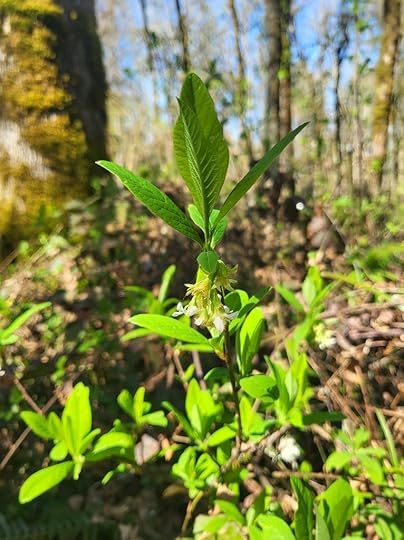 Indian Plum
Indian PlumOemleria cerasiformis
Rose Family
Native to PNW
Indian plum (also known as osoberry) is always the first plant to return in the spring, with new buds peeking out as early as December.
False HelleboreVeratrum viride
Bunchflower Family
Not native to PNW
False hellebore (also known as corn lily or Indian corn) rises from the ground very early in the spring. It starts as a tightly wound stalk of leaves before slowly opening into what resembles a stalk of corn. Please be careful, though, because this plant is poisonous!
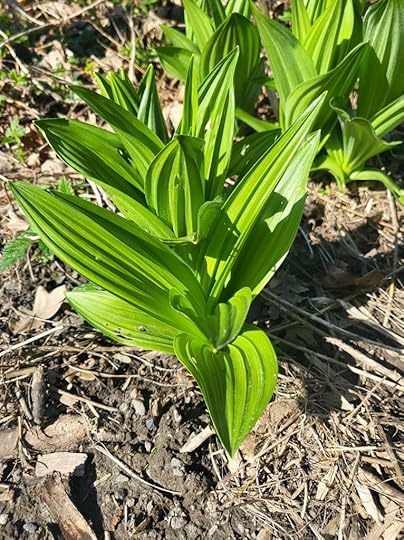
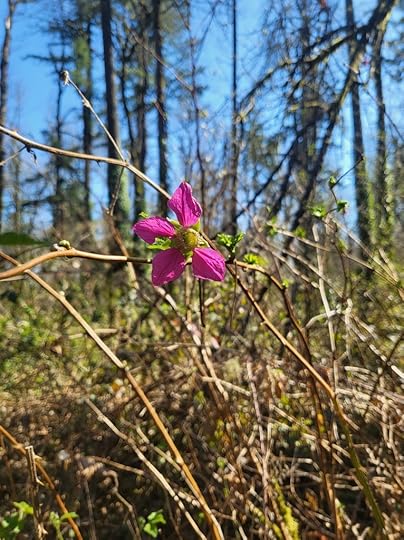 Salmonberry
SalmonberryRubus spectabilis
Rose Family
Native to PNW
Salmonberry starts putting out tiny leaf buds in the spring, as well as its first flowers. Keep an eye on these hot-pink blooms, because they’ll turn into edible berries by early summer.
Oxeye DaisyLeucanthemum vulgare
Sunflower Family
Not native to PNW
These tiny flowers are iconic symbols of spring. Growing in lawns and open fields, they’ve long been used to make daisy-chains and flower crowns!
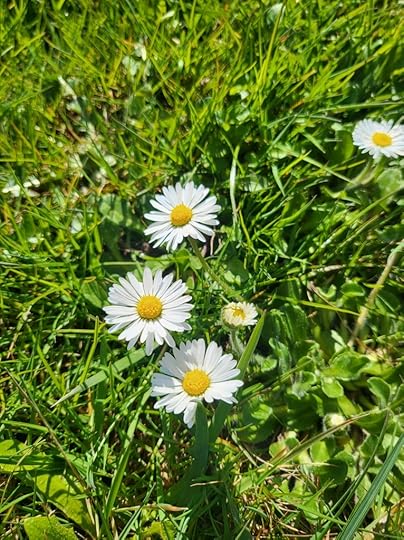
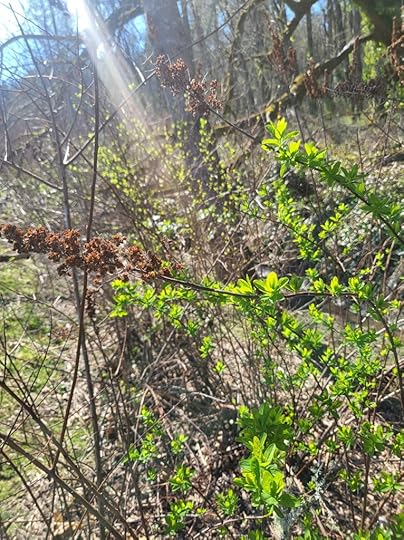 Douglas’ Spirea
Douglas’ SpireaSpirea douglasii
Rose Family
Native to PNW
Douglas’ spirea (also known as hardhack or steeplebush) starts to get its first leaves in early spring. By mid-summer, its bright pink flowers will return as well, which is great news for pollinators.
Oregon GrapeBerberis aquifolium
Barberry Family
Native to PNW
In addition to being a native plant, Oregon grape is also Oregon’s state flower. Its holly-like leaves have been around all winter, but its yellow flowers are just starting to return.
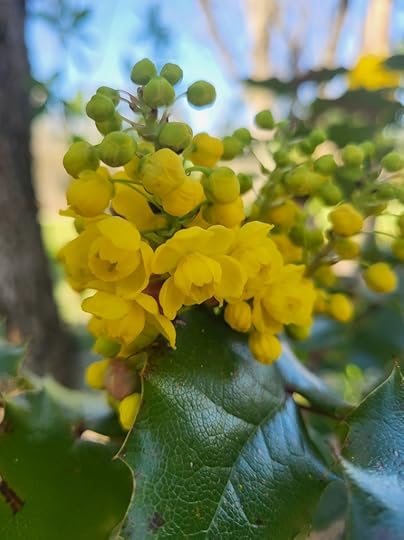
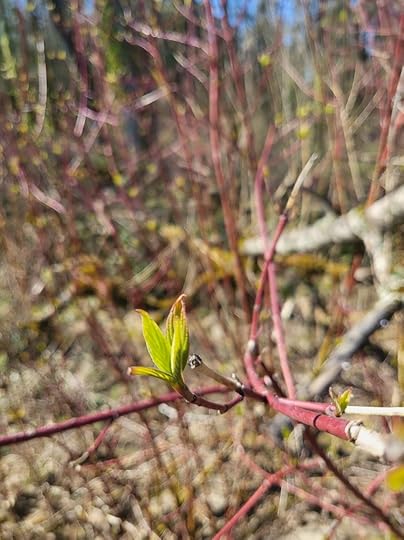 Red-Osier Dogwood
Red-Osier DogwoodCornus sericea
Dogwood Family
Native to PNW
Red-osier dogwood is named for its red branches, which add a pop of color to winter forests. Now that it’s spring, its leaves are coming back, sporting the classic deep leaf-veins of the dogwood family.
Which wild PNW plants bloom in early spring?
Yesterday was the first official day of spring here in the northern hemisphere, but the plants have been telling us that spring is here for a while now. Read on to find out which wild plants have already started blooming in Pacific Northwest forests!
 Time to read:
Time to read:
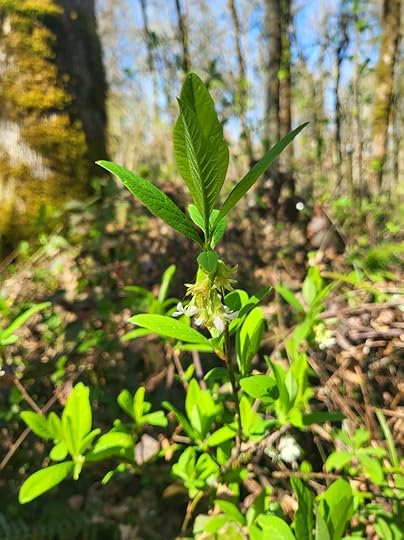 Indian Plum
Indian PlumOemleria cerasiformis
Rose Family
Native to PNW
Indian plum (also known as osoberry) is always the first plant to return in the spring, with new buds peeking out as early as December.
False HelleboreVeratrum viride
Bunchflower Family
Not native to PNW
False hellebore (also known as corn lily or Indian corn) rises from the ground very early in the spring. It starts as a tightly wound stalk of leaves before slowly opening into what resembles a stalk of corn. Please be careful, though, because this plant is poisonous!
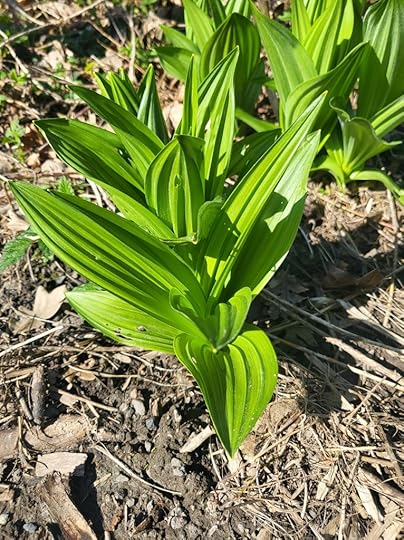
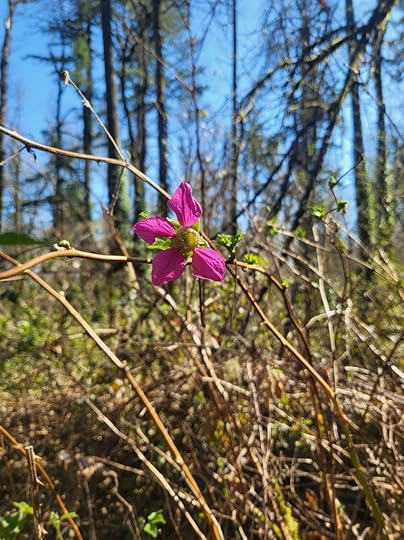 Salmonberry
SalmonberryRubus spectabilis
Rose Family
Native to PNW
Salmonberry starts putting out tiny leaf buds in the spring, as well as its first flowers. Keep an eye on these hot-pink blooms, because they’ll turn into edible berries by early summer.
Oxeye DaisyLeucanthemum vulgare
Sunflower Family
Not native to PNW
These tiny flowers are iconic symbols of spring. Growing in lawns and open fields, they’ve long been used to make daisy-chains and flower crowns!
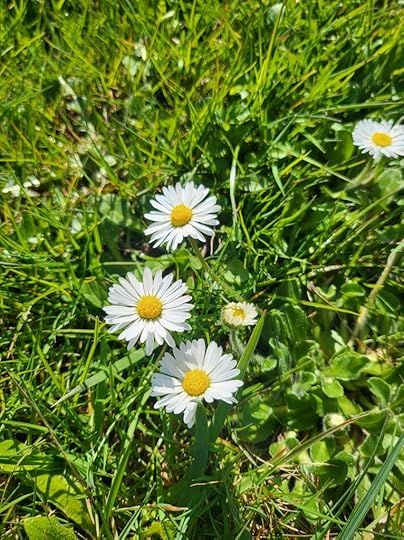
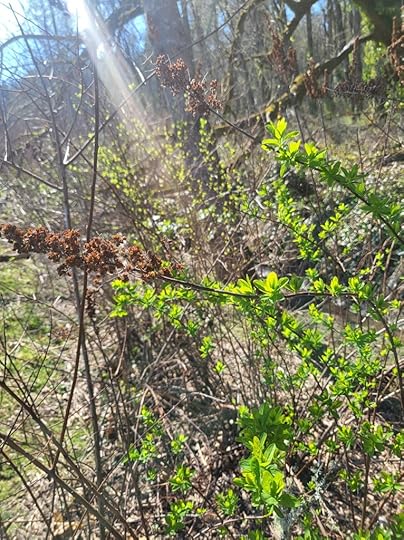 Douglas’ Spirea
Douglas’ SpireaSpirea douglasii
Rose Family
Native to PNW
Douglas’ spirea (also known as hardhack or steeplebush) starts to get its first leaves in early spring. By mid-summer, its bright pink flowers will return as well, which is great news for pollinators.
Oregon GrapeBerberis aquifolium
Barberry Family
Native to PNW
In addition to being a native plant, Oregon grape is also Oregon’s state flower. Its holly-like leaves have been around all winter, but its yellow flowers are just starting to return.
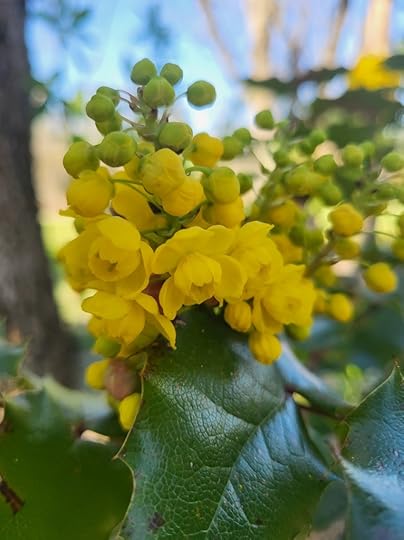
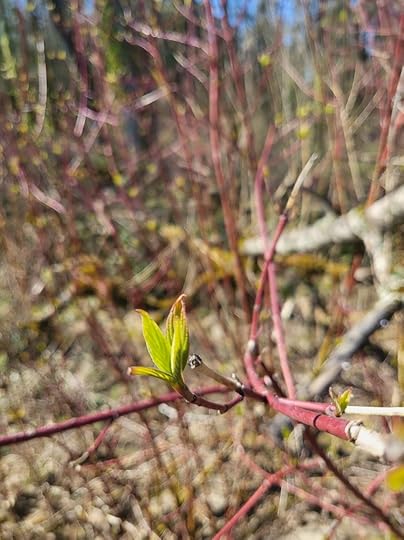 Red-Osier Dogwood
Red-Osier DogwoodCornus sericea
Dogwood Family
Native to PNW
Red-osier dogwood is named for its red branches, which add a pop of color to winter forests. Now that it’s spring, its leaves are coming back, sporting the classic deep leaf-veins of the dogwood family.
February 12, 2024
Through Time
These are the scatterings of the wind—hemlock needles, and fallen branches, and hive-shaped cones, all blanketed in snow. Our steps are strange and lumbering, and, above us, the sky is heavy.
It’s rain—the kind of rain that seeps out from tree branches and hillsides, the kind of rain that is somehow, in itself, green.
Down among the hemlocks, the light is slanted, and soft, and our footprints—wide, and bear-like—carve deep into the snow, so deep that we can see the translucent layers within them, all the fallen snow compressed and compacted, the oldest at the bottom, like rock strata.
This is deep snow, old snow, and it reflects back a perfect, pale blue, so blue that it feels like we are burrowing through glaciers, or wading through shallow mountain lakes, our heels sunk into the pebbled bottom, the sky wide and clear above us, all of time tucked somewhere beneath us, those many eons and decades and eras, ammonite shells and Australopithecus skulls, mammoth tusks and Meganeura wings, generations of bones pressed soft and crumbled into sand, all of it compressed by the weight of the earth, and then us, here, above it, the next layer, the next century, the next eon, the snow melting beneath our feet.
January 20, 2024
How To Find The Winter Constellations
Have you ever stayed out stargazing, watching the constellations inch slowly across the sky, wondering which constellation is which, and how can you find the pictures within them? Learning the constellations is easier than you’d think, and that’s because, once you’ve learned one constellation, you can learn them all. Whether it’s 10pm or 3am, January or March, winter or summer, the constellations are always in the same place in relation to each other. Read on to find out how Orion can help you locate constellations in the winter sky!

TIME TO READ
3 minutesFinding Orion – The HunterFinding Canis Major – The Big DogFinding Gemini – The TwinsFinding Taurus – The BullFinding Auriga – The CharioteerFinding Perseus – The HeroFinding Orion – The Hunter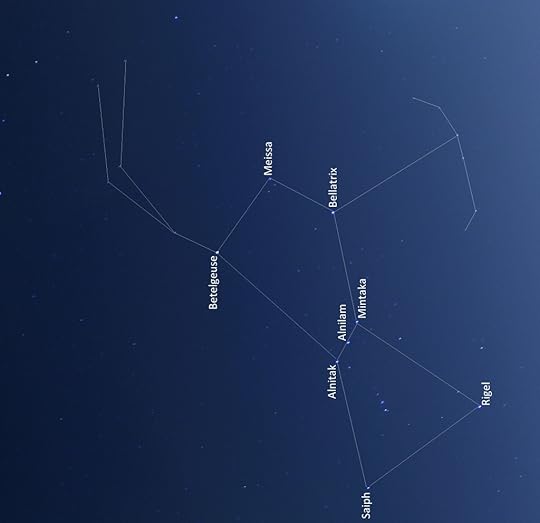 The constellation Orion.
The constellation Orion.Orion is one of the most prominent constellations in the winter sky, and it’s bright enough to be seen in even the most light-polluted cities. The easiest way to find Orion is by looking for its belt—three bright stars in a diagonal line, cutting through the middle of the constellation (see the stars Alnitak, Alnilam, and Mintaka in the graphic above). Orion is our point of reference to find all the other constellations, so we’ll keep coming back to it.
Bonus: to double check that you’ve found Orion, look to the top left, above the belt, and there should be a bright, reddish star. That’s Betelgeuse, aka Orion’s left shoulder.
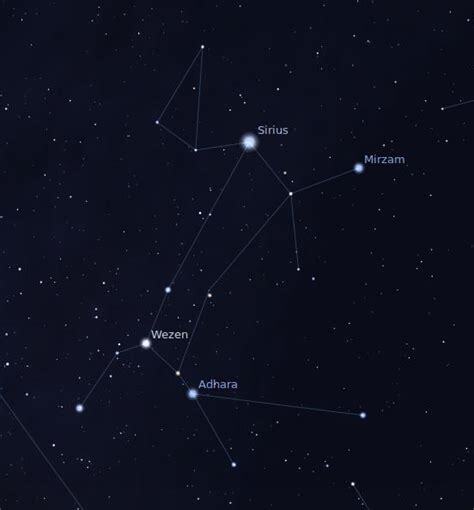 The star Sirius in the constellation Canis Major.
The star Sirius in the constellation Canis Major.Now that we know where Orion is, we can easily find our next constellation: Canis Major. Simply look to the bottom left of Orion. See that super bright, bluish star? That’s Sirius. It’s the brightest star in the winter sky, and part of the constellation Canis Major!
Finding Gemini – The Twins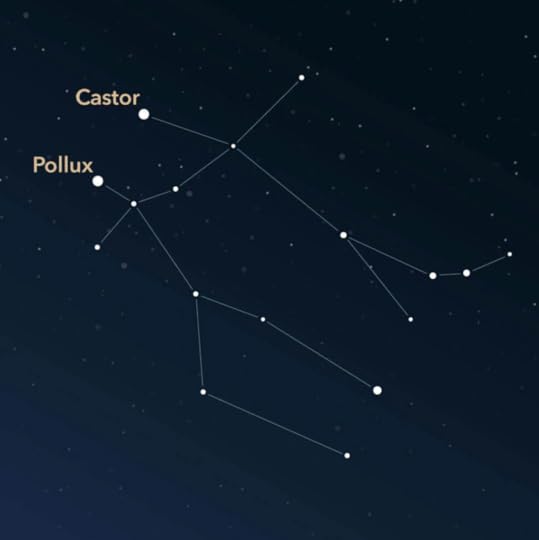 The stars Castor and Pollux in the constellation Gemini.
The stars Castor and Pollux in the constellation Gemini.Let’s head back to Orion. If we look above Orion’s left shoulder (marked by the star Betelgeuse), we’ll eventually run into two stars positioned fairly close together, one bluish and one reddish. The bluish star is Castor, and the reddish star is Pollux. These are the brightest and most visible stars within the constellation Gemini, and they make up the heads of the twins.
Finding Taurus – The Bull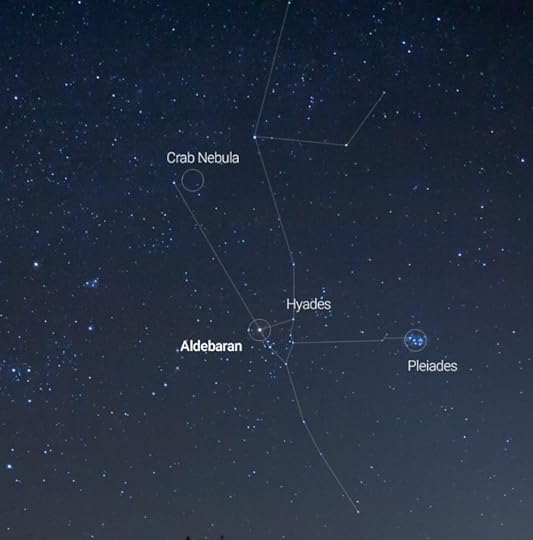 The star Aldebaran in the constellation Taurus.
The star Aldebaran in the constellation Taurus.Now let’s look above Orion’s right shoulder (marked by the star Bellatrix). Do you see a bright red star that looks a little bit like Mars? That’s Aldebaran, the most prominent star in the constellation Taurus.
Bonus: Away from city lights, look to the right of Aldebaran and you’ll see a group of small stars clustered together. This is the Pleiades, also known as the Seven Sisters, and it’s a well-known star cluster within the constellation Taurus.
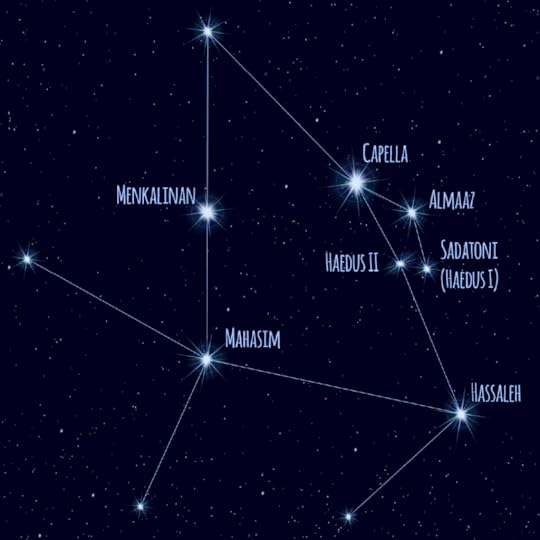 The star Capella in the constellation Auriga.
The star Capella in the constellation Auriga.We can use both Taurus and Orion to help us find our next constellation. If we go above Orion’s head (marked by the star Meissa), or to the top left of Taurus’ Aldebaran, we’ll see a yellowish star that’s almost as bright as Sirius. This is the star Capella in the constellation Auriga.
Finding Perseus – The Hero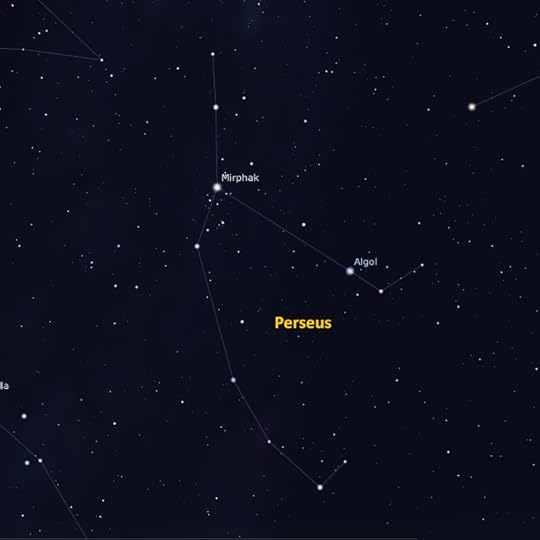 The constellation Perseus.
The constellation Perseus.Now that we’ve drifted farther away from Orion, we can find our way using Auriga. If we look to the right of Auriga, we’ll see an open-triangle shaped constellation—Perseus! There are no notably bright stars in Perseus, but it’s easy to find it by picking out the triangle shape next to Auriga.
ConclusionNow that you know some of the major winter constellations, you can constellation-hop! Perseus will help you find Cassiopeia, Cassiopeia will help you find Andromeda, Andromeda will help you find Pisces, Pisces will help you find Cetus, and so on. Let me know in the comments if you have any questions or if you want to know more. Happy stargazing!
 Book: Constellation Finder by Dorcas S. Miller App: Google Sky Map
Book: Constellation Finder by Dorcas S. Miller App: Google Sky Map
December 17, 2023
Night Sea
Night Sea
Follow me on social media for
more nature writing:
The cedar tree holds up the night,
its branches the dark blue of early dawn
in those pre-pink moments
where it is neither night or day,
and behind it the mountain sleeps in shadow
like some deep-sea giant peeking through
gold curtains of silt and seaweed,
the wind carving against it,
onto the backs of birds and whales and by-the-wind-sailors
floating up through blue layers of time,
the stars above them dipping low,
Orion rising and then sinking
into the branches
the wheel spinning, turning.
undulating, each star spiraling,
the way a wave reaches the shore
and pulls back again.
Sign up for my monthly newsletter featuring writing tips, ecology articles, giveaways, info about upcoming events, and more.
Sign up for newsletter
Processing… Success! You're on the list. Whoops! There was an error and we couldn't process your subscription. Please reload the page and try again.
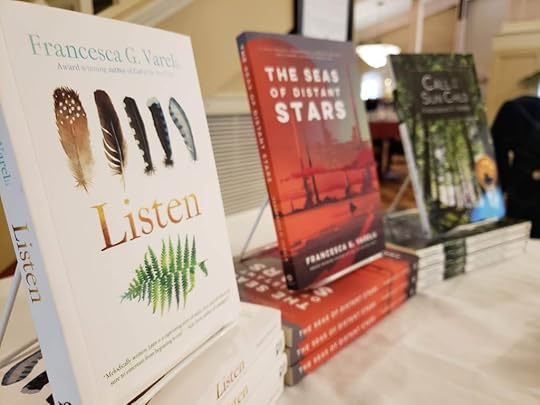 Learn more about my writing
Learn more about my writingI’m the author of four environmental and science fiction novels: Call of the Sun Child, Listen, The Seas of Distant Stars, and Blue Mar.
Read more about my booksNovember 26, 2023
The Woven Tree
The Woven Tree
Follow me on social media for
more nature writing:
Sign up for my monthly newsletter featuring writing tips, ecology articles, giveaways, info about upcoming events, and more.
Sign up for newsletter
Processing… Success! You're on the list. Whoops! There was an error and we couldn't process your subscription. Please reload the page and try again.
 Learn more about my writing
Learn more about my writingI’m the author of four environmental and science fiction novels: Call of the Sun Child, Listen, The Seas of Distant Stars, and Blue Mar.
Read more about my books


